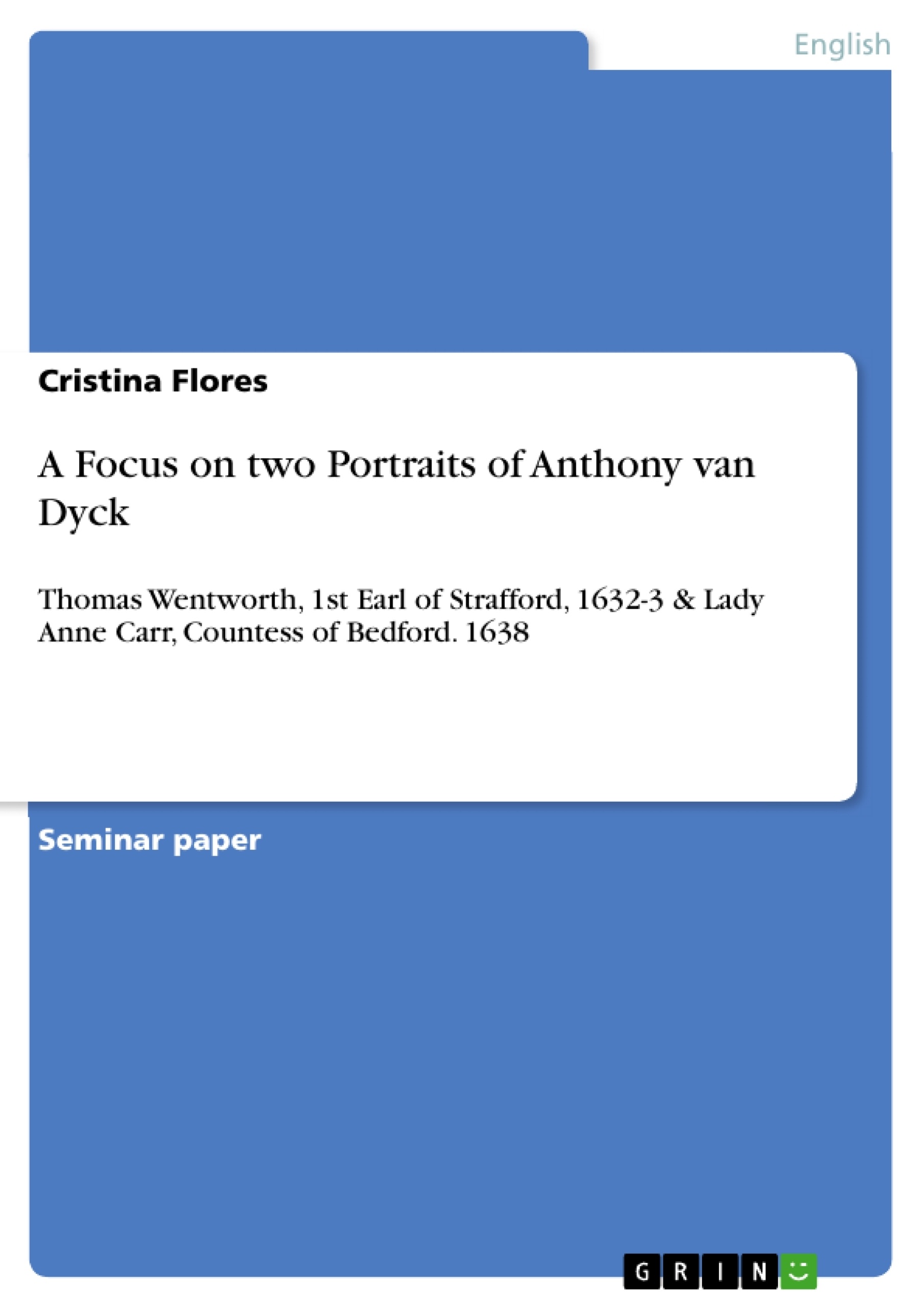In this essay I will focus on two single portraits of the Flemish painter and
portratist Anthony van Dyck (1599-1641). The first one portrays Thomas
Wentworth, 1st Earl of Strafford (1632) and the second one Lady Anne Carr,
Countess of Bedford (1638). Both paintings were painted during the 1630’s – the
Caroline era – in Britain. Charles I became the king of England in 1625 and one cansay that the first fifteen years of reign were “remarkably peaceful” even if he reigned without a parliament and only with the help of some confidants inter alia Thomas Wentworth, 1st Earl of Strafford. There were only conflicts in religious matters as Charles I married a catholic woman in Protestant England which caused the first strained relations between the two religious groups. Additionally, the Bishop of London wanted to abolish the Presbyterian Church constitution in Scotland and insert the Anglican Church instead. This led to the Scot’s protest and invasion of England. Finally, all these factors unleashed an uprising and the Civil War in the 1640’s.
Another interesting fact is that the Court of Charles I has been called the “last Renaissance Court in England [which was] extremely formal, imbued with an
atmosphere of elegance and […] high morality”. Additionally, there was the idea of Platonic Love at Court which came from Italy. Its main notion was “the transference of the Platonic pattern of divine love to a chosen lady, who was then to be worshipped as the embodiment[!] of highest perfection”.
To show all the aims and meanings of van Dyck’s portraits I chose a portrait of a man and one of a woman. In both cases I will start by noting my first impressions and then, in a second step, analyse the portrait following a precise scheme. There will be an analysis of the formal aspect and afterwards of the costume, the body and the props used. At the end, there will be a conclusion summarising the most crucial features of van Dyck’s courtly portraits.
Inhaltsverzeichnis (Table of Contents)
- Introduction
- Thomas Wentworth, 1st Earl of Strafford, 1632-3
- First Impressions
- Analysis
- Formal Aspects
- Costume and Body
- Props
- Lady Anne Carr, Countess of Bedford, 1638
- First Impressions
- Analysis
- Formal Aspects
- Costume and Body
- Props
- Conclusion
- Bibliography
Zielsetzung und Themenschwerpunkte (Objectives and Key Themes)
This essay examines two portraits by Anthony van Dyck, focusing on the portrayals of Thomas Wentworth, 1st Earl of Strafford, and Lady Anne Carr, Countess of Bedford. The analysis aims to uncover the visual strategies employed by van Dyck to convey the subjects' status, power, and persona. The essay explores the use of formal elements, costume, body language, and props to interpret the artist's intent.
- The depiction of power and status in van Dyck's portraits
- Formal analysis of van Dyck's artistic techniques
- The use of symbolic imagery in portraiture
- The influence of the Caroline era on courtly portraiture
Zusammenfassung der Kapitel (Chapter Summaries)
- Introduction: The essay introduces the context of Restoration England's rich cultural heritage and focuses on two portraits by Anthony van Dyck, highlighting the significance of the Caroline era in British art.
- Thomas Wentworth, 1st Earl of Strafford, 1632-3: This section details the first impressions of the portrait, emphasizing Wentworth's upright posture, self-confidence, and the powerful presence conveyed by his armor. The analysis explores formal aspects, costume, body language, and props, revealing the symbolic meanings behind the composition.
Schlüsselwörter (Keywords)
The primary keywords and focus topics of the text include Anthony van Dyck, Caroline era, courtly portraiture, formal analysis, symbolic imagery, power, status, costume, body language, and props.
- Quote paper
- Cristina Flores (Author), 2011, A Focus on two Portraits of Anthony van Dyck, Munich, GRIN Verlag, https://www.grin.com/document/270529



